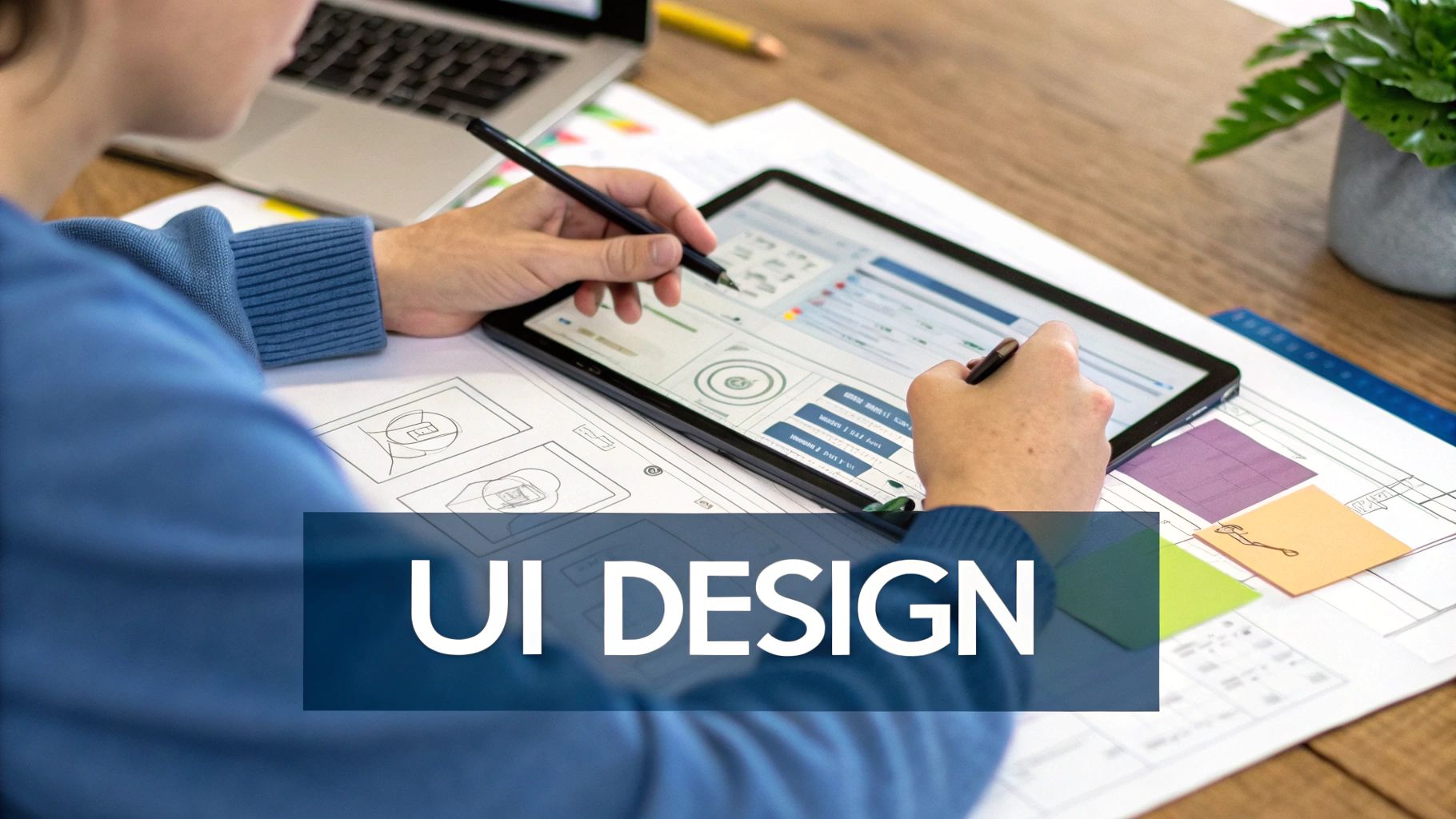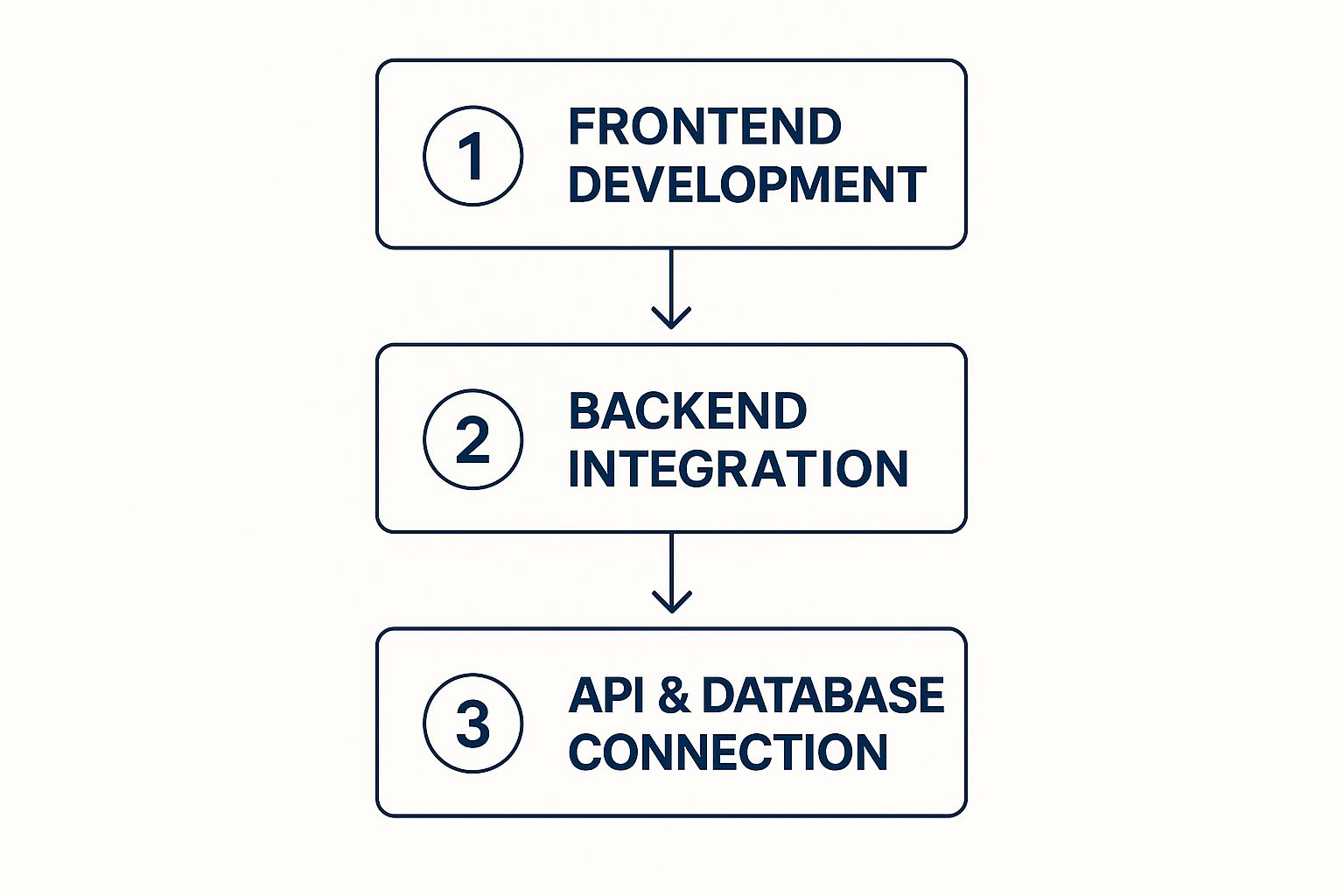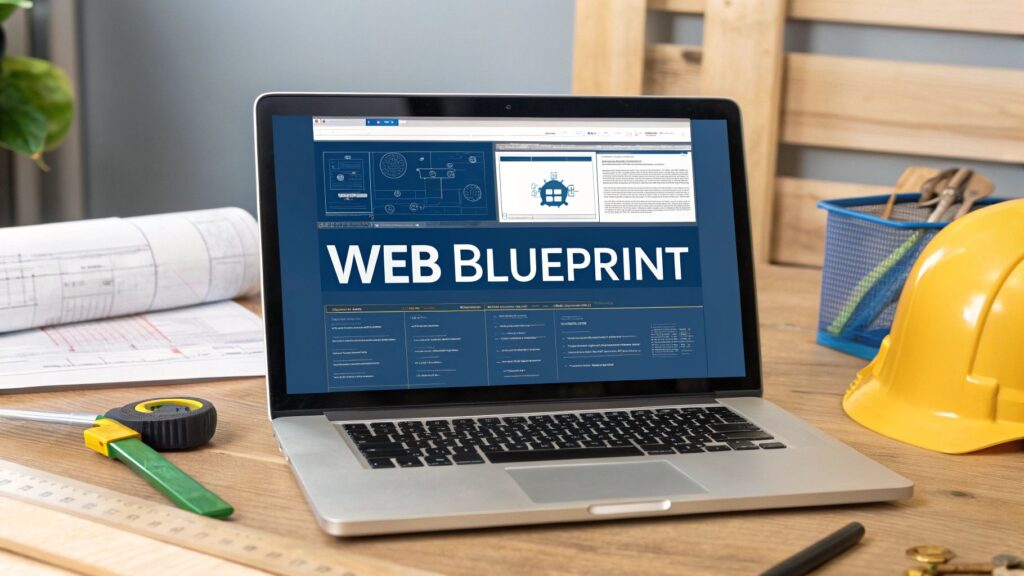At its core, website development is the service that builds, designs, and maintains your company’s online home. It’s a comprehensive process that covers everything from the visual layout a visitor sees and interacts with (the front-end) to the hidden server infrastructure and databases that make everything work (the back-end).
Think of these services as the architect, construction crew, and maintenance team for your digital presence, all rolled into one.
What Are Website Development Services Anyway?

Imagine you’re building a house. You wouldn’t just start hammering boards together without a blueprint, a solid foundation, or a skilled crew. Website development services bring that same structured, professional approach to building your digital headquarters. The goal is to create a site that’s not just nice to look at, but also functional, secure, and built for the long haul.
To understand how it all comes together, we need to look at the two disciplines that form the heart of any website project. They’re different, but they have to work in perfect harmony.
To help clarify these distinct roles, let’s break them down using our house-building analogy. Each component plays a vital part in constructing a complete and functional “digital home.”
Core Components of Website Development Services
| Component | Role & Responsibility | Analogy (Building a House) |
|---|---|---|
| Front-End Development | Builds everything the user sees and interacts with—layout, buttons, menus, and overall visual experience. | The Architect & Interior Designer: They design the floor plan, choose the paint colors, and arrange the furniture to make the house look great and feel intuitive. |
| Back-End Development | Creates the “behind-the-scenes” engine—server, database, and application logic that stores data and processes user actions. | The Foundation & Utilities: This is the concrete foundation, the electrical wiring, and the plumbing. It’s hidden but essential for the house to function. |
Seeing it this way makes it clear: you can’t have one without the other. A stunning design with a weak foundation will crumble, and a rock-solid foundation with a confusing layout will sit empty.
Front-End: The Architect and Interior Designer
The front-end is quite literally the face of your website. It’s everything your visitors see, touch, and experience directly—the layout, the colors, the fonts, and the navigation.
A front-end developer is like a digital craftsperson, using languages like HTML, CSS, and JavaScript to bring a static design to life. Their job is to make sure the user’s journey is smooth, intuitive, and maybe even a little delightful.
Back-End: The Foundation and Utilities
The back-end is the powerhouse running in the background. It’s the part of the website users never see but rely on for every single click. This includes the server that hosts the site, the database that stores information (like customer accounts or product details), and the application logic that makes everything happen.
Think of it as the plumbing and electrical wiring of your house. You don’t see it, but you’d definitely notice if it wasn’t there.
A great website is born when a seamless design (front-end) is supported by robust, invisible functionality (back-end). One without the other is either a beautiful but broken structure or a functional but uninviting space.
This organized approach is what turns a simple online brochure into a powerful business tool. In today’s market, professional web design and development isn’t just a nice-to-have; it’s a fundamental requirement for building credibility and connecting with customers.
This is especially true in rapidly growing markets. For instance, the Middle East & Africa data storage market was valued at USD 8 billion in 2025 and is projected to skyrocket to USD 27.2 billion by 2035—a CAGR of 13%. This massive infrastructure investment, particularly in the UAE, is directly fueling the demand for high-quality website development that can run on this powerful new digital foundation.
Finding the Right Type of Web Development Service

Picking a website development service is a bit like choosing the right tool for a job. You wouldn’t use a sledgehammer to hang a picture frame, right? In the same way, the kind of service you need depends entirely on what you want your website to do for your business.
There’s no one-size-fits-all solution here. The path you take should be guided by your specific goals, your budget, and the features you absolutely can’t live without. Let’s break down the main categories to help you figure out which one makes the most sense for you.
Custom Web Development
Think of custom web development as getting a suit tailor-made. It’s built from scratch, from the ground up, to fit your business like a glove. This is the path for businesses that have very specific needs—maybe a unique feature, a complex integration with another system, or a brand identity so distinct that a template just won’t cut it.
For instance, a real estate agency might need a custom property search engine that pulls data from multiple MLS listings and includes an interactive map. An off-the-shelf solution would likely fall short. This approach gives you total control, but be prepared for a higher price tag and a longer development timeline.
E-commerce Development
An online store is a whole different beast than a simple brochure website. E-commerce development is a specialized field focused on one thing: building a powerful, secure, and easy-to-use online shop. It’s not just about displaying products; it’s about creating a smooth journey from browsing to checkout.
This kind of service handles all the critical components that make an online store tick:
- Secure Payment Gateways to handle transactions without a hitch.
- Product Catalog Management so you can easily add products and track inventory.
- Shopping Cart and Checkout Systems designed to be simple and prevent abandoned carts.
- Customer Account Features for tracking orders and saving information.
Whether you’re just starting out or ready to scale, dedicated e-commerce website services are essential for turning clicks into customers. These platforms are engineered to manage everything from payment security to high traffic during a big sale.
CMS-Based Development
Ever wonder how people update their blogs or news sites so easily? They use a Content Management System (CMS). A CMS is a platform that lets you manage your website’s content without having to be a coding wizard. For businesses that are all about content—like blogs, magazines, or corporate sites that need frequent updates—this is the perfect fit.
The most well-known example is WordPress, which runs a staggering 43% of all websites on the internet. A developer can take a CMS like this, customize a theme, add plugins for extra functionality, and hand you the keys. It’s generally a faster and more budget-friendly route than building from scratch, making it ideal for a business that needs to publish articles or case studies without calling a developer every time.
Web Application Development
So, what’s the difference between a website and a web application? A website is mostly for viewing information. A web app is for doing things. Think about Google Docs or a project management tool like Asana—those are applications that you access right in your browser.
Web application development is all about creating these kinds of interactive tools. This is for companies whose main product is the software itself, like a financial dashboard for investors or a collaborative platform for designers. These are incredibly complex projects that demand serious expertise in both front-end (what you see) and back-end (what makes it all work) technology to create a smooth, reliable experience.
The real question isn’t which service is “best,” but which one aligns with your business. A straightforward CMS site is perfect for a local plumber, while a complex web application is non-negotiable for a SaaS company.
Website Maintenance and Support
Getting your website live is the starting line, not the finish line. Just like a car needs regular maintenance to keep running well, your website needs ongoing attention to stay secure and perform at its best. This is where maintenance and support services come in.
Think of it as an insurance policy for your digital storefront. This crucial service usually covers:
- Security Updates: Patching holes to protect your site from new threats.
- Software Updates: Keeping your CMS and all its plugins current.
- Performance Checks: Making sure your site stays fast and responsive for visitors.
- Regular Backups: Saving a copy of your site, just in case disaster strikes.
- Bug Fixes: Squashing any technical glitches that pop up after launch.
Skipping out on maintenance is a risky move. Over time, even the most beautiful website can become slow, vulnerable to hackers, or just plain broken. It’s an absolutely essential part of any serious online strategy.
The Web Development Process From Start to Finish
Hiring a team for website development can feel a bit like commissioning a custom-built house. You have a clear picture of the final product in your head, but the actual process of getting there—from pouring the foundation to picking out the paint—can seem like a mystery. Breaking down that process is key. A well-defined plan isn’t just about ticking boxes; it’s what turns a great idea into a powerful, functional website.
Think of the entire project as a collaborative journey. It starts long before a single line of code is written and keeps going well after your site launches. Each step builds on the last, making sure the final product is perfectly aligned with your business goals from the very beginning.
Discovery And Strategy: The Blueprint Phase
This first stage is, without a doubt, the most important. This is where your development partner puts on their architect hat. They’ll dig deep to understand your vision, what you want to achieve, and who you’re trying to reach. Trying to rush this part is like building a house without a blueprint—you might get something standing, but it almost certainly won’t be what you needed.
During discovery, we nail down the answers to a few critical questions:
- What’s the main goal? Are we trying to generate leads, sell products online, or simply provide information?
- Who is our user? We need to get inside their heads to understand their needs, frustrations, and how comfortable they are with technology.
- What features are absolute must-haves? This conversation defines the scope of the project, from simple contact forms to complex, interactive user dashboards.
Getting this strategic foundation right guides every single decision that follows.
Design And Development: The Construction Phase
With a solid plan in hand, it’s time to start building. This is where the visual and technical pieces come together, and your website really begins to take shape.
- UI/UX Design: First up, designers create wireframes. Think of these as the basic skeletal outlines of your site’s pages. From there, they build out mockups and prototypes, which add the color, branding, and interactive feel. The entire focus here is on creating a user experience (UX) that feels intuitive and a user interface (UI) that looks great.
- Front-End Development: Now, developers take those static designs and bring them to life. Using languages like HTML, CSS, and JavaScript, they build the part of the website that people actually see and interact with in their web browsers.
- Back-End Development: This is the engine room. Back-end developers build the server-side logic, databases, and application programming interfaces (APIs) that make everything on the front-end work. This is where user accounts are managed, data is stored safely, and all the complex behind-the-scenes functions happen.
This image gives a great, simplified view of how these core parts of development work together.

The front-end is what the user sees, but it relies on the back-end to connect to databases and APIs to deliver a complete, dynamic experience. For bigger, more intricate projects, understanding the specifics of a custom web app development process is essential for managing all these moving parts.
Choosing The Right Development Approach
Not all projects are built the same way. The methodology a team uses can have a huge impact on everything from timelines to the final product. Here’s a quick breakdown of the most common approaches to help you understand which might be the best fit for your needs.
| Methodology | Best For | Pros | Cons |
|---|---|---|---|
| Agile | Complex, evolving projects where requirements might change. | Highly flexible, collaborative, and allows for rapid iterations. | Can lead to “scope creep” if not managed well; less predictable timeline. |
| Waterfall | Projects with clearly defined, fixed requirements from the start. | Structured, predictable, and well-documented process. | Inflexible; difficult and costly to make changes once a phase is complete. |
| Scrum | A popular Agile framework for projects needing quick turnarounds. | Breaks work into short “sprints,” promoting fast progress and regular feedback. | Requires a dedicated team and can be intense to manage. |
| Kanban | Continuous delivery projects focused on workflow visualization. | Excellent for maintenance and support; very flexible and transparent. | Can be less effective for projects with hard deadlines. |
Ultimately, the best approach depends entirely on your project’s specific goals, budget, and timeline. A good development partner will help you choose the right model before any work begins.
Testing And Deployment: The Final Inspection
Before your website is introduced to the world, it has to go through some serious testing. The Quality Assurance (QA) team becomes a pack of bug-hunters, meticulously checking for glitches, making sure the site works across all browsers and devices, and confirming every feature runs smoothly. They test everything from broken links to payment gateways.
A website is never truly “finished.” The launch is just the beginning.
Once the QA team gives the all-clear, the site is deployed to a live server and is officially public. But the job isn’t done. Making sure your site is built with strong software development security best practices from day one is non-negotiable. After launch, ongoing support—including security monitoring, regular backups, and software updates—is what protects your investment and keeps your site running perfectly for the long haul.
Decoding the Cost of Website Development

One of the first questions on everyone’s mind is, “So, what’s this new website going to cost me?” It’s a perfectly reasonable question, but there’s no simple price tag. A website isn’t an off-the-shelf product; it’s a custom-built tool, and its price is tied directly to what you need it to do for your business.
Think of it like buying a vehicle. You might need a reliable sedan for your daily commute, or you might need a heavy-duty truck kitted out with specialized equipment for a construction job. Both are vehicles, but their purpose, complexity, and price are worlds apart. Website development services work the exact same way.
To really get a handle on a realistic budget, you have to break down the key ingredients that make up the final price.
Scope and Complexity
By far, the biggest driver of cost is the sheer size and complexity of your project. Are you looking for a simple online brochure to introduce your services, or do you need a sophisticated web application that your customers will log into and use every day? The difference in the work involved is enormous.
- Simple “Brochure” Site: This is your classic 5-10 page website with basic info, a contact form, and standard pages. It’s the “sedan” of the web world—functional, professional, and gets the job done.
- Complex Web Application: Think of a platform with user accounts, interactive dashboards, data processing, and completely custom features. This is the “heavy-duty truck,” built from the ground up for specific, demanding tasks.
The more pages, unique features, and custom logic your site needs, the more time and expertise it will demand from developers, which naturally drives up the cost.
Design Uniqueness and User Experience
How your website looks and feels is another huge piece of the cost puzzle. This isn’t just about picking nice colors; it’s about crafting a smooth, intuitive journey for every visitor. The choice usually boils down to using a pre-made template or going for a fully custom design.
A template-based design is like buying a pre-built home. It’s faster and more affordable because the fundamental structure already exists. A developer can then tailor it with your branding and content, but the overall layout is largely set in stone.
A fully custom UI/UX design, on the other hand, is like hiring an architect to design your dream home from scratch. This process involves deep research into your audience, creating wireframes and prototypes, and building a one-of-a-kind visual identity. The result is a far superior experience that’s perfectly aligned with your brand, but it requires a much bigger investment.
A website’s cost is a direct reflection of its purpose. A simple online presence is an expense, but a high-performing site designed to generate leads and sales is an investment in your company’s growth.
Technology Stack and E-commerce Needs
The actual technology used to build your website also plays a big part. Different programming languages, frameworks, and platforms come with different development costs, often based on their complexity and how many skilled developers are available. For example, a basic site built on WordPress will almost always cost less than a complex application built with a niche JavaScript framework.
If you plan to sell products online, e-commerce functionality becomes a major cost factor. And it’s so much more than just adding a “buy now” button. You have to account for:
- Secure payment gateway integrations
- Product catalog management systems
- Inventory tracking and order fulfillment logic
- Complex shipping and tax calculations
These features demand specialized expertise to make sure everything is secure, reliable, and easy for customers to use. On top of that, integrating your site with third-party tools like a CRM, marketing automation platform, or accounting software adds another layer of complexity and cost. Each one of those connections has to be carefully built and tested to ensure data flows exactly where it needs to.
The web development market in the UAE really highlights these complexities, especially with regional factors like talent availability and ambitious digital transformation goals. A shortage of mid-career developers has pushed salaries up by over 40% globally between 2023 and 2025, which in turn increases the cost of website development. This talent gap and wage inflation have likely bumped up project budgets by 10-15% per year in the region, particularly as UAE companies in finance, healthcare, and e-commerce require incredibly secure and scalable platforms.
How to Choose the Right Web Development Partner
Finding the right web development partner is probably the single most important decision you’ll make for your project. This isn’t just about hiring someone to write code. You’re searching for a strategic ally who truly gets your business vision and knows how to turn it into a digital experience that works.
Sure, a flashy portfolio is nice, but it doesn’t reveal the whole picture. The best partners feel like an extension of your own team. They’ll question your assumptions (in a good way!), bring fresh ideas to the table, and genuinely care about your success long after the site goes live. To find that kind of fit, you have to look deeper.
Dig Into Their Portfolios and Case Studies
Start by really digging into a potential partner’s portfolio. Don’t just skim for pretty designs. Look for direct experience in your industry or with projects that have a similar scope and complexity to yours. Have they built sites for businesses like yours? If they have, it’s a huge plus—it means they already have a head start on understanding your audience, your challenges, and what you need functionally.
Then, go beyond the portfolio and look at their case studies. A solid case study isn’t just a project summary; it’s a success story backed by data. It should clearly lay out the client’s original problem, the solution the agency built, and—most importantly—the measurable results. Look for hard numbers, like a boost in website traffic, better conversion rates, or more engaged users.
Get a Feel for Their Process and Communication
A professional agency always has a well-defined and transparent process. Ask them to walk you through how they handle a typical project, from the initial discovery and strategy sessions all the way through design, development, testing, and launch. A clear roadmap is a great sign that they’re organized, experienced, and won’t leave you with nasty surprises.
Just as crucial is how they communicate. How often will you get updates? Who will be your main point of contact?
A great development partner makes clear, consistent communication a priority. They should feel like a collaborative ally who is easy to reach, not some mysterious vendor you have to chase down.
Look for a team that sets up a regular meeting schedule and uses project management tools to keep everyone on the same page. This ensures you’re always in the loop and an active part of your project’s journey.
Verify Their Technical Chops and Ongoing Support
Make sure their technical skills are a perfect match for what you need. If your goal is a powerful e-commerce store, ask about their experience with platforms like Shopify or Magento. If you need a complex custom application, find out which programming languages and frameworks they specialize in. Don’t hesitate to ask direct questions to confirm they have the right tools for your specific job.
This is especially true in fast-growing markets. For instance, the demand for sophisticated website development services in the UAE is skyrocketing as e-commerce reshapes the region. The Middle East’s cross-border e-commerce market hit around USD 15.83 billion in 2024 and is expected to grow at a CAGR of over 30% through 2033. This explosion means you need a partner who can build sites that handle high traffic, secure payments, and deliver flawless user experiences.
Finally, get crystal clear on what happens after your site launches. A website isn’t a “set it and forget it” project; it needs ongoing care. Ask about their maintenance plans, how quickly they respond to urgent issues, and how they manage security updates and performance checks. A partner who’s truly invested in your success will have a reliable support plan ready to go.
Common Questions About Website Development
Jumping into a website project can feel like learning a new language, filled with terms and processes that might not be familiar. It’s only natural to have a lot of questions, especially when you’re about to make a significant investment in your business’s digital home.
Let’s clear the air and tackle some of the most common questions we hear from clients. Getting these answers upfront helps everyone get on the same page and ensures the whole process runs smoothly from kickoff to launch day.
How Long Does It Take to Build a Website?
This is usually the first thing people ask, and the most honest answer is: it really depends on what we’re building. A simple, clean website with a few pages to showcase your services might only take a few weeks. Think of it like building a small, charming cabin.
But if you need a sprawling e-commerce store with thousands of products, custom payment gateways, and integrations with your inventory system, that’s more like building a multi-story commercial complex. A project like that could easily take six months, or even longer.
The timeline is shaped by a few key things:
- Scope and Features: How many pages do you need? Are there special features like a customer portal, booking system, or interactive tools?
- Design Complexity: A fully custom design built from scratch takes more time than starting with a flexible, pre-designed template.
- Content Readiness: A common delay happens when we’re waiting on text, images, or videos. Having your content ready to go makes a huge difference.
- Feedback Loops: The project moves fastest when feedback is clear and timely. Long gaps or frequent changes in direction can stretch the schedule.
The best way to get a solid timeline is to have your development partner create a detailed project roadmap with clear milestones for each stage.
What Is the Difference Between Web Design and Web Development?
People often use these terms interchangeably, but they’re actually two different sides of the same coin. They work hand-in-hand, but they focus on very different things.
Think of it like building a house. Web design is the architect and interior designer. It’s all about the blueprint, the look and feel, and how people will move through the space. Designers focus on user experience (UX), creating wireframes and mockups that map out a visitor’s journey. They choose the colors, fonts, and layouts that make the site intuitive and beautiful.
Web development, on the other hand, is the construction crew. Developers take those beautiful designs and turn them into a real, functioning website using code. They’re the ones who pour the foundation and put up the walls. This work is generally split into two areas:
- Front-End Development: This is the finish work—painting the walls, installing fixtures, and making sure the light switches work. Front-end developers use code like HTML, CSS, and JavaScript to build the parts of the site you can see and interact with.
- Back-End Development: This is the plumbing, electrical, and HVAC system hidden in the walls. Back-end developers manage the server, the database, and the core application logic that makes everything run smoothly behind the scenes.
A great website needs both. Amazing design with shoddy development is like a beautiful house with leaky pipes. And solid development without good design is like a structurally sound building that’s impossible to navigate. The magic happens when they come together.
Is Ongoing Website Maintenance Really Necessary?
In one word: absolutely. Launching your website is the starting line, not the finish line. Skipping maintenance is like buying a brand-new car and then refusing to ever get an oil change or check the tires. For a while, it’ll run fine, but eventually, you’re heading for a major breakdown.
Website maintenance is the essential service that protects your investment and keeps it running at peak performance. It’s not just about fixing things when they break; it’s about preventing them from breaking in the first place. You can’t improve your key website metrics for growth if your site is slow, buggy, or offline.
Here’s what regular maintenance typically covers:
- Security Scans and Updates: The internet is a wild place. Regular updates patch security holes to keep hackers and malware out.
- Software Updates: Your website’s platform (like WordPress) and its plugins need to be updated constantly to fix bugs and stay secure.
- Site Backups: If the worst happens, having a recent backup means you can restore your site in minutes instead of losing everything.
- Performance Checks: Keeping an eye on site speed and fixing bottlenecks ensures your visitors (and Google) stay happy.
Without maintenance, your site becomes slower, less secure, and more likely to crash. It’s a non-negotiable part of keeping your online presence healthy and professional.
Will My New Website Work on Mobile Devices?
Yes, 100%. This isn’t even a question of “if” anymore—it’s a baseline requirement for any modern website. Any credible developer will build your site using a responsive design approach.
Responsive design simply means the website automatically adapts its layout to look great and work perfectly on any screen, from a giant desktop monitor to a tablet to a smartphone.
With over 58% of all internet traffic now coming from mobile phones, having a site that isn’t mobile-friendly is like locking the door to more than half of your potential customers. Even worse, Google heavily prioritizes mobile-friendly sites in its search results. If your site doesn’t work well on a phone, you’ll be practically invisible online. Today, a professional website is a mobile-responsive website.
Ready to build a powerful, professional website that drives results? The team at Invocom offers end-to-end website development services designed to help your business grow. From custom designs to secure e-commerce solutions, we build digital experiences that deliver. Get in touch with us today to discuss your project.





